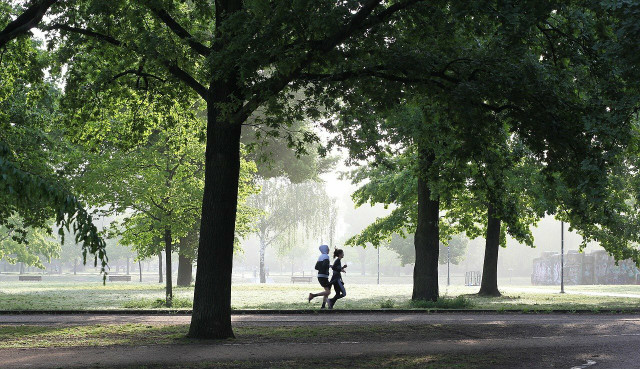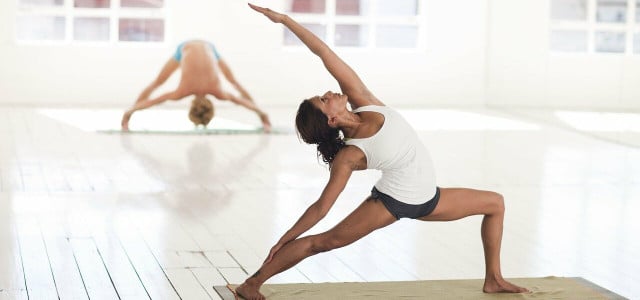Slow jogging is a great workout for athletes and couch potatoes alike. Whether you're just getting into fitness or looking to change it up, try slow jogging.
Popularized by Japanese Professor Hiroaki Tanaka, slow jogging is a way to make exercise easy, straightforward and fun. Instead of focusing on a fast pace with high intensity, slow jogging is all about taking your time. The goal is to run at a speed comfortable for you to carry on a conversation. You may want to start with fast walking depending on your fitness level. As you make slow jogging a habit, your speed will likely increase naturally. You can always run faster if you wish; the goal is simply to go at a pace that is easy and comfortable.
Slow jogging is beneficial to all, but it’s an especially effective exercise for those who are a bit less fit and trying to integrate workouts into their life. While other types of exercise may be hard on your joints and muscles, slow jogging is a more chill workout that anybody can do. Still, athletes like marathon runners partake in slow jogging as well. The main idea behind slow jogging emphasizes that faster isn’t always better. You can enjoy exercise’s myriad health and wellness benefits without pushing yourself to the max.
Benefits of Slow Jogging



(Foto: CC0 / Pixabay / wal_172619)
Slow jogging comes with a number of advantages to your mental and physical health. It can also benefit you in other ways, including:
- Motivation: It can be challenging to motivate yourself to get out of the house and do an intense, intimidating workout. Getting into shape with slow jogging is a great way to stay positive about exercise.
- Form: Sometimes, running fast may be more detrimental than beneficial to your health. If you are not an experienced runner, start with slow jogging to focus on your form and ensure you are running in a productive, healthy way.
- Endurance: Jogging slowly helps you last longer! Rather than doing several quick sprints, go slow jogging to build up your endurance. Soon, you’ll be jogging miles farther than you could have imagined.
- Rest time: Since slow jogging isn’t as hard on your body as other forms of exercise, such as HIIT workouts and weight training, it allows you to integrate workouts into your daily life easily. You won’t need to give your body as many rest days to recover as typically required for intense workouts. Instead, you can enjoy slow jogging every day you wish.
- Injury Prevention: You decrease your risk of injury by doing more chill workouts rather than putting your body in harm’s way.
- Health benefits: Any exercise is better than no exercise, meaning slow jogging has the same health benefits as any other workout. It’s great for your respiratory, cardiovascular and muscular health. Slow jogging also burns calories, as with different exercises. You can even burn more calories through slow jogging because you can do it more frequently and for a longer time than other workouts.
- Fun: Slow jogging is fun! It’s a great way to keep in touch with friends, get to know your neighborhood and grab some fresh air. Instead of stressing about your “best time,” enjoy your time outside regardless of how long you go for.
- Consistency: Because of all the benefits, slow jogging is easy to stick with. Enjoying your workout will make you want to exercise more frequently. Soon, slow jogging will become a regular habit.
How To Get Started Slow Jogging



(Foto: CC0 / Pixabay / RoonzNL)
As with any new exercise, gettings started can be the hardest part. Here’s how to make it easy:
- Set reasonable goals: Don’t worry about frequency, speed or mileage. This might mean aiming to run just two times a week. Make sure not to push yourself too hard with speed. The whole point of slow jogging is to go at a comfortable, steady, sustainable pace. Consider starting with fast walking around the block, and work your way up to a light jog throughout the neighborhood.
- Focus on your form: Make sure you jog slowly enough to maintain proper form. This includes good posture. Engage your core and keep your eyes forward to prevent tilting your head down and slumping your shoulders.
- Use a mid-foot strike: Unlike fast jogging, where your feet hit the ground heel-first, slow jogging involves a mid-foot strike. Use short strides so your feet hit the ground in the middle of the arch, putting less strain on your joints.
- Stay comfy: Make sure to hold the pace that’s most comfortable for you. You should be running slow enough to carry on a conversation. If you’re running alone, crack a smile. If you’re too focused or tired to do either, slow down.
Read more:
- Running in Spring: 6 Tips for a Fresh Start
- Rise and Shine: 3 Major Benefits of a Morning Workout
- 5 Scenic Amtrak Routes You Need to Check Out
Important Information regarding Health-related Topics.
** Links to retailers marked with ** or underlined orange are partially partner links: If you buy here, you actively support Utopia.org, because we will receive a small part of the sales proceeds. More info.Do you like this post?








